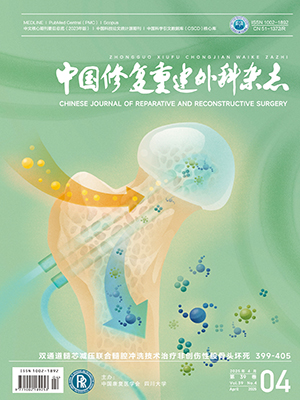| 1. |
Florczyk SJ, Leung M, Li Z, et al. Evaluation of three-dimensional porous chitosan-alginate scaffolds in rat calvarial defects for bone regeneration applications. J Biomed Mater Res A, 2013, 101(10): 2974-2983.
|
| 2. |
詹健峰, 刘徐妹, 于博. 载 BMP-2 多肽 P24 的巯基化壳聚糖水凝胶诱导异位成骨的实验研究. 中国修复重建外科杂志, 2018, 32(9): 1144-1149.
|
| 3. |
王福科, 刘流, 赵德萍, 等. 体外血管内皮细胞和脂肪干细胞联合培养对脂肪干细胞成骨分化的影响. 中国修复重建外科杂志, 2010, 24(4): 399-405.
|
| 4. |
王福科, 刘流, 何晓光, 等. 血管内皮细胞和脂肪干细胞体外联合培养细胞的增殖. 中国组织工程研究与临床康复, 2010, 14(32): 6001-6005.
|
| 5. |
李彦林, 杨志明, 解慧琪, 等. 生物衍生骨支架材料的体外细胞相容性实验研究. 中国修复重建外科杂志, 2001, 15(4): 227-231.
|
| 6. |
杨浩, 李彦林, 韩睿, 等. 异种骨衍生材料修复节段性骨缺损的实验研究. 昆明医学院学报, 2004, 25(1): 14-18.
|
| 7. |
李彦林, 杨志明, 解慧琪, 等. 生物衍生组织工程骨支架材料的制备及理化特性. 生物医学工程学杂志, 2002, 19(1): 10-12.
|
| 8. |
王福科, 刘流, 代晓明, 等. 纤维粘连蛋白对部分脱蛋白骨细胞相容性影响研究. 昆明医学院学报, 2010, 31(1): 9-14.
|
| 9. |
裴雪涛. 干细胞实验指南. 北京: 科学出版社, 2006: 83-100.
|
| 10. |
王福科, 刘流, 赵德萍, 等. 大鼠脐血来源单个核细胞诱导为内皮祖细胞的免疫荧光检测. 中国生物美容, 2009, 1(4): 10-15.
|
| 11. |
王福科, 赵德萍, 代晓明, 等. 不同类型血清对大鼠脂肪干细胞分离培养的影响. 昆明医学院学报, 2010, 31(3): 4-10.
|
| 12. |
Han X, Liu L, Wang F, et al. Reconstruction of tissue-engineered bone with bone marrow mesenchymal stem cells and partially deproteinized bone in vitro. Cell Biol Int, 2012, 36(11): 1049-1053.
|
| 13. |
刘流, 王福科, 赵德萍, 等. 联合培养 VECs 与 ADSCs 与部分脱蛋白生物骨体外构建组织工程骨的实验研究. 中国生物美容, 2010, 1(1): 1-9.
|
| 14. |
宁钰, 秦文, 任亚辉, 等. 载淫羊藿苷/凹凸棒石/Ⅰ型胶原/聚己内酯复合支架修复兔胫骨缺损的实验研究. 中国修复重建外科杂志, 2019, 33(9): 1-13.
|
| 15. |
冯立, 曹晓建, 任永信. 纤维粘连蛋白与碱性成纤维细胞生长因子对成骨细胞黏附的协同刺激作用. 中国修复重建外科杂志, 2007, 21(4): 390-395.
|
| 16. |
García AJ, Reyes CD. Bio-adhesive surfaces to promote osteoblast differentiation and bone formation. J Dent Res, 2005, 84(5): 407-413.
|
| 17. |
Williams JT, Southerland SS, Souza J, et al. Cells isolated from adult human skeletal muscle capable of differentiating into multiple mesodermal phenotypes. Am Surg, 1999, 65(1): 22-26.
|
| 18. |
Nakagawa T, Tagawa T. Ultrastructural study of direct bone formation induced by BMPs-collagen complex implanted into an ectopic site. Oral Dis, 2000, 6(3): 172-179.
|
| 19. |
Li H, Daculsi R, Grellier M, et al. The role of vascular actors in two dimensional dialogue of human bone marrow stromal cell and endothelial cell for inducing self-assembled network. PLoS One, 2011, 6(2): e16767.
|
| 20. |
Wang DS, Miura M, Demura H, et al. Anabolic effects of 1,25-dihydroxyvitamin D3 on osteoblasts are enhanced by vascular endothelial growth factor produced by osteoblasts and by growth factors produced by endothelial cells. Endocrinology, 1997, 138(7): 2953-2962.
|
| 21. |
Inglis S, Christensen D, Wilson DI, et al. Human endothelial and foetal femur-derived stem cell co-cultures modulate osteogenesis and angiogenesis. Stem Cell Res Ther, 2016, 7: 13.
|
| 22. |
Kusumbe AP, Ramasamy SK, Adams RH. Coupling of angiogenesis and osteogenesis by a specific vessel subtype in bone. Nature, 2014, 507(7492): 323-328.
|
| 23. |
Liang Y, Wen L, Shang F, et al. Endothelial progenitors enhanced the osteogenic capacities of mesenchymal stem cells in vitro and in a rat alveolar bone defect model. Arch Oral Biol, 2016, 68: 123-130.
|
| 24. |
Verseijden F, Posthumus-van Sluijs SJ, Pavljasevic P, et al. Adult human bone marrow- and adipose tissue-derived stromal cells support the formation of prevascular-like structures from endothelial cells in vitro. Tissue Eng Part A, 2010, 16(1): 101-114.
|
| 25. |
孙源, 林红, 吴子征, 等. 联合培养时诱导的内皮细胞对自体骨髓基质干细胞成骨作用的影响. 中华创伤骨科杂志, 2006, 8(10): 919-923.
|
| 26. |
Zhao X, Liu L, Wang FK, et al. Coculture of vascular endothelial cells and adipose-derived stem cells as a source for bone engineering. Ann Plast Surg, 2012, 69(1): 91-98.
|
| 27. |
董苑, 杨瑞年, 王福科, 等. BMP2 的表达对联合培养体系中骨髓间充质干细胞增殖和成骨分化的影响. 中华显微外科杂志, 2013, 36(4): 352-355.
|
| 28. |
杨瑞年, 刘流, 王福科, 等. 联合培养体系中对骨髓间充质干细胞 Bmi-1 表达的影响. 中国组织工程研究, 2012, 16(14): 2524-2529.
|
| 29. |
杨瑞年, 刘流, 王福科, 等. 血管内皮细胞对联合培养体系中骨髓间充质干细胞侏儒症相关转录因子表达及成骨分化的影响. 中国组织工程研究, 2012, 16(19): 3447-3449.
|




